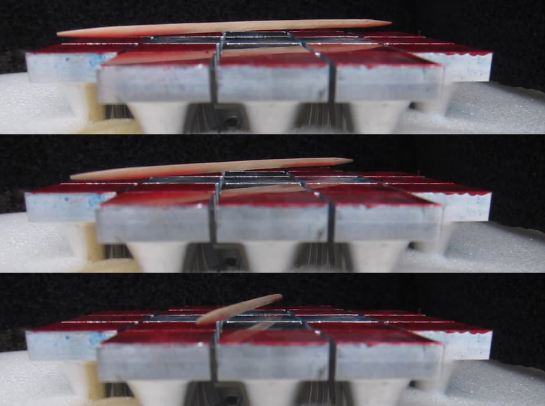Levitation with acoustic waves
July 16, 2013

A toothpick levitates and rotates on acoustic waves (credit: Daniele Foresti/ETH Zurich)
ETH researchers can make objects such as particles and liquid droplets fly in mid-air by letting them ride on acoustic waves. They can also control their movement and merge droplets, which can react chemically or biologically. They can even rotate a toothpick in the air.
The magic trick is based on acoustic waves, reveals Daniele Foresti, former doctoral student now a postdoctoral researcher at the Laboratory of Thermodynamics in Emerging Technologies.
Moving objects such as particles or droplets of a liquid freely in mid-air makes it possible to investigate processes while avoiding any disruptive contact with a surface. For instance, some chemical reactions and biological processes are compromised by surfaces, and certain substances disintegrate on contact with a surface.
Magnets not required
Until now, scientists have been able to generate such a “contact-free” levitational state only with the help of magnets, electrical fields, or in liquids, with the help of buoyancy. These methods, however, limit the selection of materials that can be handled.
“It is extremely difficult to levitate and precisely move a drop of liquid with a magnet. The fluid has to possess magnetic properties. In liquids, where buoyancy force supports levitation, you can only use immiscible liquids such as a drop of oil in water,” explains Dimos Poulikakos, Professor of Thermodynamics and head of the research project.
With acoustic waves, in contrast, it is possible to levitate various objects regardless of their properties. The limiting factor is the maximum diameter of the object, which must correspond to half the wavelength of the acoustic wave being used. An object reaches the stationary levitated state when all the forces acting on it are in equilibrium.
In other words, the force of gravity that pulls the object in one direction is counteracted by an equally large force in the opposite direction. This force comes from the acoustic wave, which the researchers generate as a standing wave between an emitter and a reflector that reverberates the acoustic waves. The force of the acoustic wave pushes against the object and thus prevents it from falling due to gravity. It is conceptually similar to the air jet from a fan that keeps a ping-pong ball in the air.
Creating instant coffee in midair
The knowledge that acoustic waves can exert a force — the acoustic radiation pressure effect — on an object to keep it in suspension was discovered more than 100 years ago. Until now, however, no one had been successful in controlling the motion of objects riding on acoustic waves in mid-air. Foresti achieved this goal by switching on multiple emitter-reflector modules in parallel next to each other. He varied the acoustic waves from module to module to transfer particles or droplets of liquid from one module to the next.
In a test run, Foresti used this method to move a granule of instant coffee onto a droplet of water and merge the two. In a further experiment, he mixed two droplets of liquid with different pH values, one alkaline and the other acidic; the resulting droplet contained a fluorescent pigment that glows only at a neutral pH value. In a video, he captured how the two droplets mix and the pigment begins to glow.
“This method of moving levitated objects could have a wide range of possible applications,” says Foresti. The process of controlled movement can run in parallel with several objects, making it interesting for industrial applications.
For example, some biological and chemical experiments require particles or droplets of source material to be initially processed and then analyzed. With this technique, researchers can mix tiny amounts of substances and liquids in a step by step manner without any chemical changes arising due to contact with a surface.
The researchers have tested the method with droplets and particles that are several millimeters in diameter. The excitation of the acoustic waves has to be chosen after careful theoretical analysis: if the acoustic force exceeds the surface force of a certain liquid, the droplet is atomized explosively.
The researchers successfully levitated drops of water, hydrocarbons, and various solvents.